Swatch Group Bundle
Can a Watchmaker Weather Any Storm? Examining the Swatch Group.
The Swatch Group, a titan in the Swiss watchmaking and global luxury watch industry, commands attention. This multinational powerhouse not only crafts exquisite timepieces but also exerts considerable influence across the consumer goods sector. From its iconic Swatch to prestigious brands like Omega, understanding the Swatch Group SWOT Analysis is key to grasping its multifaceted operations.
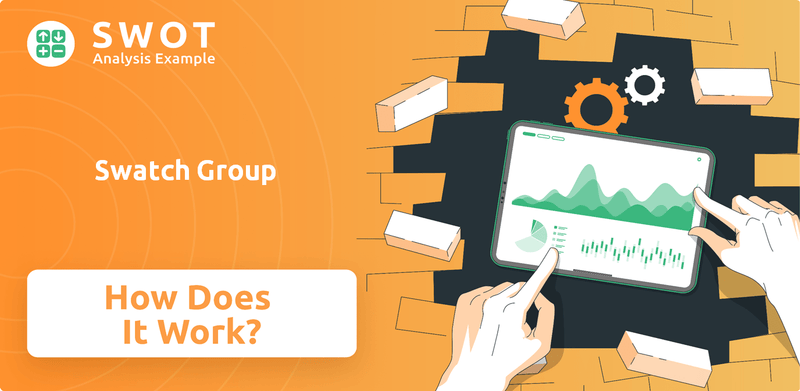
Despite facing market headwinds in 2024, Swatch Group demonstrated resilience, achieving record sales in key markets. This analysis will delve into the Swatch Group structure, its diverse brand portfolio, and the strategic decisions that underpin its long-term viability. We'll explore how this leader in watch manufacturing navigates challenges and capitalizes on opportunities to maintain its position in the luxury watch industry.
What Are the Key Operations Driving Swatch Group’s Success?
The core operations of the Swatch Group revolve around the design, manufacturing, and sale of watches, jewelry, watch movements, and components. This includes electronic systems used across various industries. The company's strength lies in its vertically integrated manufacturing process, allowing it to produce almost all components for its 16 watch brands.
This extensive industrial base, combined with advanced robotics and traditional craftsmanship, enables high-precision manufacturing. The group caters to a diverse customer base through its multi-tiered brand portfolio, spanning from mass-market products to luxury brands. Continuous innovation, like the development of new materials and collaborative collections, further enhances its appeal.
The company's operational processes involve meticulous sourcing, technology development, and a robust distribution network, including physical retail stores, an online platform, and authorized dealers. This blend of industrial scale and artisanal expertise, with a strategic focus on local production and sustainability, sets it apart. The group's commitment to sustainability is evident in initiatives to reduce environmental impact, with over 90% of its suppliers meeting its sustainability criteria, as reported in recent years.
The Swatch Group structure includes a wide range of brands, each targeting different customer segments. From the accessible Swatch and Flik Flak to the luxury offerings of Breguet and Omega, the portfolio ensures broad market coverage. This multi-brand strategy allows the company to capture diverse consumer preferences and price points.
The company's manufacturing prowess is a key differentiator in the watch manufacturing sector. Advanced robotics and new technologies are integrated with traditional craftsmanship to ensure high precision. The Vallée de Joux workshops, for example, preserve the art of mechanical movement production. This approach allows for both efficiency and quality.
Swatch Group's distribution strategy combines physical retail stores, an online platform, and a network of authorized dealers. This multi-channel approach ensures a wide market reach. The company's presence in key markets worldwide strengthens its brand visibility and accessibility for customers.
Sustainability is a core value, with initiatives focused on reducing environmental impact and using sustainable materials. The company's innovation extends to new materials and collaborative collections, such as the MoonSwatch, which generated significant demand. These efforts highlight the company's commitment to both environmental responsibility and market relevance.
The Swatch Group's success is built on a combination of industrial scale, artisanal expertise, and a strategic focus on sustainability. This approach has allowed the company to maintain a strong position in the luxury watch industry. The company's ability to innovate and adapt to market trends is also critical.
- Vertical integration allows for control over the entire manufacturing process.
- A diverse brand portfolio caters to various customer segments.
- Commitment to sustainability enhances brand image and customer loyalty.
- Continuous innovation drives market differentiation and growth.
Swatch Group SWOT Analysis
- Complete SWOT Breakdown
- Fully Customizable
- Editable in Excel & Word
- Professional Formatting
- Investor-Ready Format
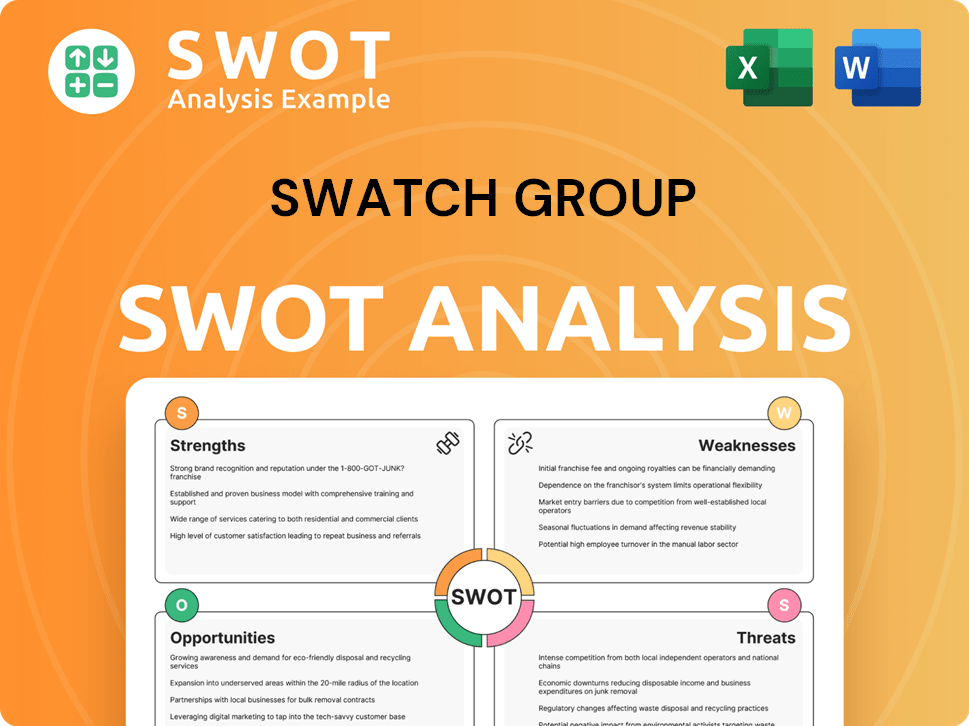
How Does Swatch Group Make Money?
The revenue streams and monetization strategies of Swatch Group are diverse, primarily driven by direct sales of its watches and jewelry. These sales occur through both physical retail stores and its online platform, www.swatch.com. The company's financial performance is closely tied to its ability to effectively manage its brand portfolio and adapt to shifts in global markets.
Swatch Group leverages various innovative monetization strategies beyond direct sales. This includes limited-edition collections and artist collaborations, which generate significant buzz and drive sales. The company also utilizes its network of authorized dealers to broaden its market reach and enhance its retail distribution.
In 2024, the Group's total net sales amounted to CHF 6,735 million. The Watches & Jewellery segment (without Production) is the largest contributor to revenue, with sales of CHF 6.42 billion. The retail share of the Watches & Jewellery segment's total sales rose to 47% in 2024.
Primary revenue source through physical retail stores and online platforms.
Strategic releases to generate excitement and boost sales.
Expanding market reach through a network of dealers.
Focus on markets like the USA, Japan, and the Middle East to offset declines in other regions.
Revenue from subsidiaries like EM, Renata, and Micro Crystal.
Ongoing investments in marketing and events, such as the Olympic Games, to increase brand visibility.
Swatch Group's revenue mix is influenced by regional dynamics. While sales in China decreased in 2024, other key markets showed strong performance. The diverse brand portfolio, including Omega, Longines, and Tissot, contributes to revenue diversification. The electronic systems segment also generates revenue, and marketing investments support brand visibility. For more insights, you can explore the Brief History of Swatch Group.
Swatch Group's financial success hinges on several key factors.
- Direct sales through retail and online channels.
- Successful launches of limited-edition products.
- Strategic expansion into high-growth markets.
- Effective management of its diverse brand portfolio.
- Revenue from electronic systems and marketing initiatives.
Swatch Group PESTLE Analysis
- Covers All 6 PESTLE Categories
- No Research Needed – Save Hours of Work
- Built by Experts, Trusted by Consultants
- Instant Download, Ready to Use
- 100% Editable, Fully Customizable
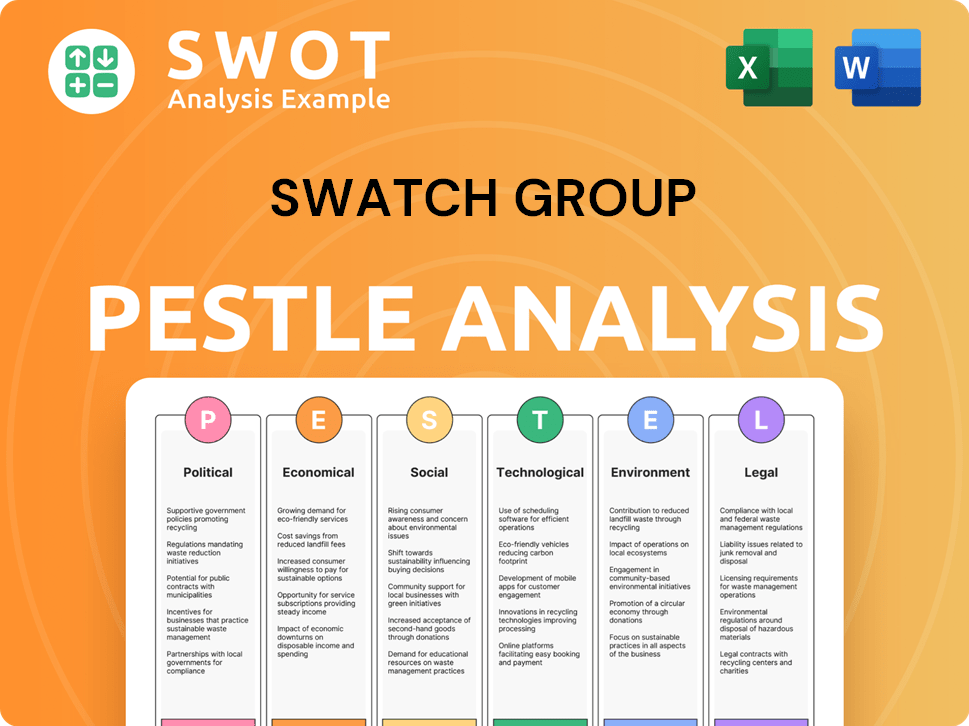
Which Strategic Decisions Have Shaped Swatch Group’s Business Model?
The story of the Swatch Group is a compelling one of strategic innovation and market dominance. The company's trajectory is marked by key milestones and strategic shifts that have solidified its position in the competitive landscape of the Swiss watchmaking and luxury watch industry. From its inception to its current status, the Swatch Group has consistently adapted to market dynamics, leveraging its diverse brand portfolio and technological prowess to maintain a competitive edge.
A pivotal moment was the merger of ASUAG and SSIH, forming the Swatch Group AG. This move was instrumental in streamlining operations and reducing costs within the Swiss watchmaking sector. The launch of the original Swatch watch in 1983, priced affordably at $39.90, democratized Swiss craftsmanship and propelled the brand into cultural and market dominance, selling over 1 billion units by 1995. This strategic move not only saved the Swiss watch industry but also set the stage for future expansion and diversification.
The Swatch Group's strategic moves have been crucial in shaping its current market position. In 1992, the company expanded its portfolio by acquiring luxury watch brands such as Breguet, Blancpain, and Omega, positioning itself as a leader in both mass-market and high-end segments. The company has also faced challenges, including a drop in demand in China and Southeast Asia in 2024, which led to a decline in sales and a lower operating margin in the Watches & Jewellery segment. Despite these challenges, the group has maintained a focus on safeguarding jobs and supporting its workforce.
The establishment of Swatch Group AG through the merger of ASUAG and SSIH was a critical step in streamlining operations. The launch of the original Swatch watch in 1983, priced at $39.90, revolutionized the industry. The acquisition of luxury brands like Breguet, Blancpain, and Omega in 1992 expanded its market reach.
The Swatch Group has consistently adapted to market dynamics, leveraging its diverse brand portfolio. The company has focused on safeguarding jobs and supporting its workforce during economic downturns. Investing in sustainability and expanding its digital presence are key strategic initiatives.
The Swatch Group has a strong brand portfolio covering all price segments. It invests heavily in research and development, with 196 new patent applications in 2024. Vertical integration provides economies of scale and a cost advantage.
The company faced a drop in demand for consumer goods in China and Southeast Asia in 2024. This led to a decline in sales and a lower operating margin in the Watches & Jewellery segment. Despite these challenges, the company maintains a long-term strategic focus.
The Swatch Group's competitive advantages are multi-faceted, stemming from its brand strength, technological leadership, and vertical integration. Its diverse brand portfolio, covering all price segments, allows it to cater to a broad range of consumer tastes. The company's vertical integration provides economies of scale and a cost advantage.
- Brand Strength: A portfolio of 16 prestigious brands catering to various consumer segments.
- Technology Leadership: Intensive R&D activities, with 196 new patent applications in 2024.
- Vertical Integration: Economies of scale and cost advantages in manufacturing.
- Innovation: The MoonSwatch collaboration demonstrates its ability to create buzz and drive demand.
- Sustainability: Investing in eco-friendly practices and materials.
To understand more about Swatch Group's strategic approach, consider reading about the Growth Strategy of Swatch Group. The Swatch Group's ability to adapt and innovate, coupled with its strong brand portfolio and operational efficiencies, positions it well for future growth. The company's focus on sustainability and digital expansion also indicates its commitment to meeting evolving consumer preferences and market conditions.
Swatch Group Business Model Canvas
- Complete 9-Block Business Model Canvas
- Effortlessly Communicate Your Business Strategy
- Investor-Ready BMC Format
- 100% Editable and Customizable
- Clear and Structured Layout
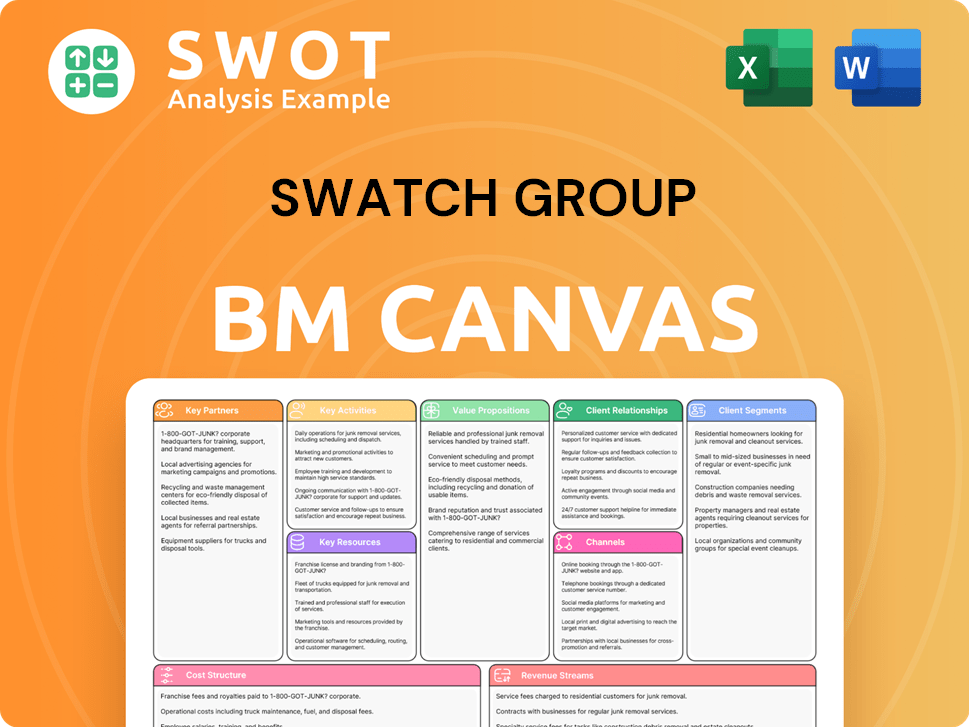
How Is Swatch Group Positioning Itself for Continued Success?
The Swatch Group holds a prominent position in the global watchmaking industry, recognized as the world's largest watchmaking group. Its diverse portfolio, encompassing 16 brands, allows it to serve a wide range of customers, from those seeking affordable fashion watches to those desiring high-end luxury timepieces. This wide spectrum enables the company to maintain a broad customer base and a global presence.
In 2024, the Swiss watch industry faced challenges, with overall exports decreasing by 2.8% compared to 2023. Despite these industry-wide headwinds, the Swatch Group managed to achieve record sales and market share gains in several regions, including the USA, Japan, India, and the Middle East, with brands like Omega, Longines, and Tissot performing strongly. For more insights, you can explore the Owners & Shareholders of Swatch Group.
The Swatch Group is the leading player in the Swiss watchmaking industry. Its extensive brand portfolio allows it to cover nearly every segment of the market. The company's global presence is a key strength.
The company faces risks related to the challenging market conditions and weak consumer demand in China. Negative currency impacts also pose a challenge. Competition from privately-owned luxury watch brands is another key risk.
The Swatch Group anticipates positive momentum in 2025, with strategic initiatives including expansion in growth markets like India and the Middle East. The company is also focusing on direct-to-consumer strategies and online retail. Expectations include improved sales and operating results.
The company is targeting growth markets to diversify beyond China. Strengthening mid-range and accessible luxury brands is a key focus. Enhancing direct-to-consumer strategies and online retail is also a priority.
In 2024, the Swatch Group faced headwinds, particularly in China, but still achieved strong sales in other regions. The company's strategic focus includes innovation and sustainability, with 196 new patent applications in 2024.
- Weak demand in China significantly impacted 2024 sales.
- Negative currency impacts amounted to CHF 192 million in 2024.
- The company expects substantial improvements in 2025.
- Ongoing strategic initiatives include targeting growth markets.
Swatch Group Porter's Five Forces Analysis
- Covers All 5 Competitive Forces in Detail
- Structured for Consultants, Students, and Founders
- 100% Editable in Microsoft Word & Excel
- Instant Digital Download – Use Immediately
- Compatible with Mac & PC – Fully Unlocked
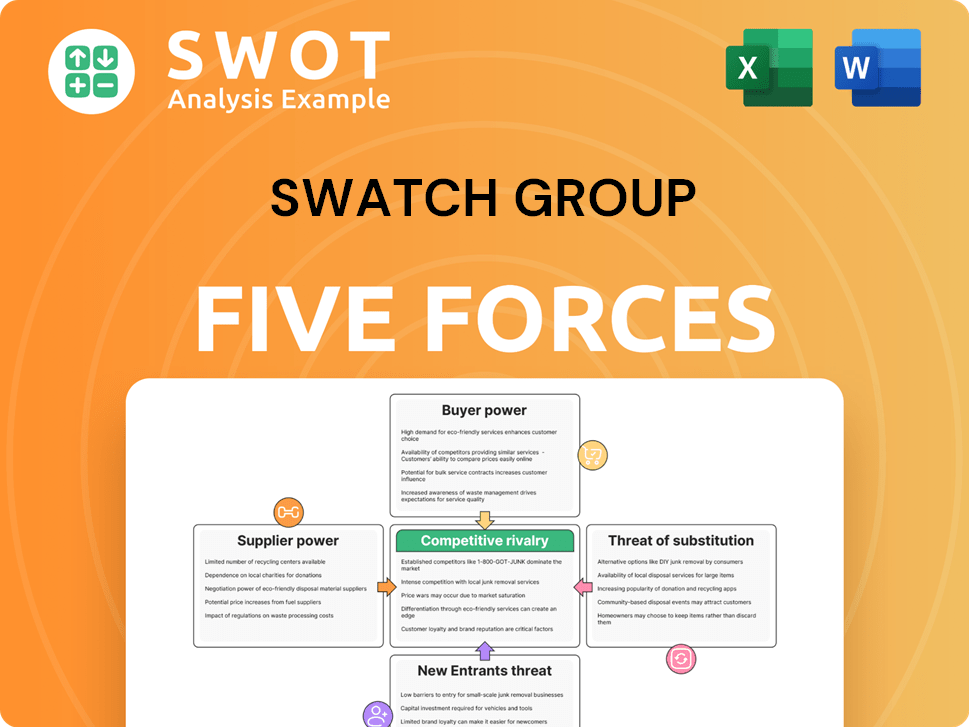
Related Blogs
- What are Mission Vision & Core Values of Swatch Group Company?
- What is Competitive Landscape of Swatch Group Company?
- What is Growth Strategy and Future Prospects of Swatch Group Company?
- What is Sales and Marketing Strategy of Swatch Group Company?
- What is Brief History of Swatch Group Company?
- Who Owns Swatch Group Company?
- What is Customer Demographics and Target Market of Swatch Group Company?
Disclaimer
All information, articles, and product details provided on this website are for general informational and educational purposes only. We do not claim any ownership over, nor do we intend to infringe upon, any trademarks, copyrights, logos, brand names, or other intellectual property mentioned or depicted on this site. Such intellectual property remains the property of its respective owners, and any references here are made solely for identification or informational purposes, without implying any affiliation, endorsement, or partnership.
We make no representations or warranties, express or implied, regarding the accuracy, completeness, or suitability of any content or products presented. Nothing on this website should be construed as legal, tax, investment, financial, medical, or other professional advice. In addition, no part of this site—including articles or product references—constitutes a solicitation, recommendation, endorsement, advertisement, or offer to buy or sell any securities, franchises, or other financial instruments, particularly in jurisdictions where such activity would be unlawful.
All content is of a general nature and may not address the specific circumstances of any individual or entity. It is not a substitute for professional advice or services. Any actions you take based on the information provided here are strictly at your own risk. You accept full responsibility for any decisions or outcomes arising from your use of this website and agree to release us from any liability in connection with your use of, or reliance upon, the content or products found herein.